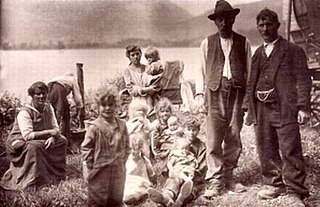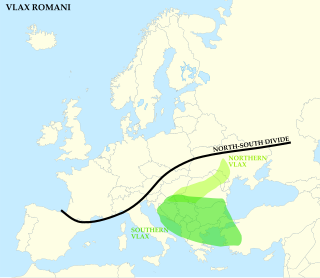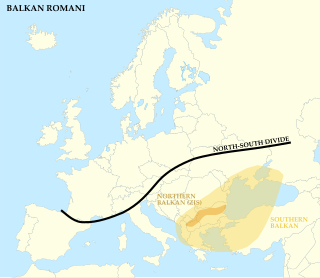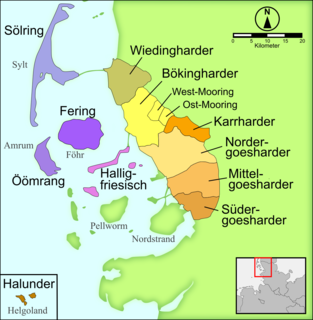
Franz Miklosich was a Slovene philologist.
Romani is an Indo-Aryan macrolanguage of the Romani communities. According to Ethnologue, seven varieties of Romani are divergent enough to be considered languages of their own. The largest of these are Vlax Romani, Balkan Romani (600,000), and Sinte Romani (300,000). Some Romani communities speak mixed languages based on the surrounding language with retained Romani-derived vocabulary – these are known by linguists as Para-Romani varieties, rather than dialects of the Romani language itself.

Lemkos are an ethnic group inhabiting the Lemko Region of Carpathian Rus', an ethnographic region in the Carpathian Mountains and foothills spanning Ukraine, Slovakia and Poland.

Carpathian Germans are a group of ethnic Germans. The term was coined by the historian Raimund Friedrich Kaindl (1866–1930), originally generally referring to the German-speaking population of the area around the Carpathian Mountains: the Cisleithanian (Austrian) crown lands of Galicia and Bukovina, as well as the Hungarian half of the Austro-Hungarian monarchy, and the northwestern (Maramuresch) region of Romania. Since the First World War, only the Germans of Slovakia and those of Carpathian Ruthenia in Ukraine have commonly been called Carpathian Germans.

The Yenish are an itinerant group in Western Europe who live mostly in Germany, Austria, Switzerland, Luxembourg, Belgium, and parts of France, roughly centred on the Rhineland. A number of theories for the group's origins have been proposed, including that the Yenish descended from members of the marginalized and vagrant poor classes of society of the early modern period, before emerging as a distinct group by the early 19th century. Most of the Yenish became sedentary in the course of the mid-19th to 20th centuries.

Vlax Romani is a dialect group of the Romani language. Vlax Romani varieties are spoken mainly in Southeastern Europe by the Romani people. Vlax Romani can also be referred to as an independent language or as one dialect of the Romani language. Vlax Romani is the second most widely spoken dialect subgroup of the Romani language worldwide, after Balkan Romani.
The Romani language has for most of its history been an entirely oral language, with no written form in common use. Although the first example of written Romani dates from 1542, it is not until the twentieth century that vernacular writing by native Romani people arose.
Bohemian Romani or Bohemian Romany is a dialect of Romani formerly spoken by the Romani people of Bohemia, the western part of today's Czech Republic. It became extinct after World War II, due to extermination of most of its speakers in Nazi concentration camps.
Domari is an endangered Indo-Aryan language, spoken by Dom people scattered across the Middle East and North Africa. The language is reported to be spoken as far north as Azerbaijan and as far south as central Sudan, in Turkey, Iran, Iraq, Palestine, Israel, Jordan, Egypt, Sudan, Libya, Tunisia, Algeria, Morocco, Syria and Lebanon. Based on the systematicity of sound changes, it is known with a fair degree of certainty that the names Domari and Romani derive from the Indo-Aryan word ḍom. However, the Domari and Romani languages do not derive from the same ancestor idiom. Domari derives from an Indo-Aryan language. The Arabs referred to them as Nawar as they were a nomadic people that originally immigrated to the Middle East from the Indian subcontinent.
Burgenland Croatian is a regional variety of the Chakavian dialect of Croatian spoken in Austria, Hungary, the Czech Republic, Poland and Slovakia. Burgenland Croatian is recognized as a minority language in the Austrian state of Burgenland, where it is spoken by 19,412 people according to official reports (2001). Many of the Burgenland Croatian speakers in Austria also live in Vienna and Graz, due to the process of urbanization, which is mostly driven by the poor economic situation of large parts of Burgenland.

Medzev, also known as Metzenseifen is a town and large municipality in Košice-okolie District in the Košice Region of eastern Slovakia. It is one of several towns in Bodva Valley. Other towns in Bodva Valley include: Jasov, Lucia Bania, Vyšný Medzev, and Stos. Historically, It belonged to one of the original mountain towns in the Lower Zips/Dolný Spis: Gelnica/Göllnitz, Smolník/Schmöllnitz, Nálepkovo/Wagendrüssel, Krompachy/Krompach, Mníšek nad Hnilcom/Einsiedel, Švedlár/Schwedler.
Carinthian Slovenes or Carinthian Slovenians are the indigenous minority of Slovene ethnicity, living within borders of the Austrian state of Carinthia, neighboring Slovenia. Their status of the minority group is guaranteed in principle by the Constitution of Austria and under international law, and have seats in the National Ethnic Groups Advisory Council.

Balkan Romani, Balkaniko Romanes, or Balkan Gypsy is a specific non-Vlax dialect of the Romani language, spoken by groups within the Balkans, which include countries such as Albania, Bosnia-Herzegovina, Bulgaria, Greece, Kosovo, North Macedonia, Serbia, Slovenia, Turkey etc. The Balkan Romani language is typically an oral language.
Sinte Romani is the variety of Romani spoken by the Sinti people in Germany, France, Austria, Belgium, the Netherlands, some parts of Northern Italy and other adjacent regions. Sinte Romani is characterized by significant German influence and is not mutually intelligible with other forms of Romani. The language is written in the Latin script.

Northern Romani is group of dialects of the Romani language spoken in various Northern European, Central European and Eastern European countries.

Goesharde Frisian is a collective term for three of the ten dialects of the North Frisian language. Goesharde Frisian is spoken in the historical Goesharde region north of Husum. The three distinct dialects are Northern, Central and Southern Goesharde Frisian. The latter became extinct with the death of the two last speakers in 1980 and 1981 in Hattstedt. Central Goesharde Frisian is therefore now the southernmost dialect of mainland North Frisian. Two local varieties of Northern Goesharde have been extensively catalogued, those spoken around the villages of Langenhorn and Ockholm.

Hungarian has ten dialects. These are, for the most part, mutually intelligible, and do not differ significantly from standard Hungarian. They are mostly distinguished by pronunciation; although there are differences in vocabulary, these are usually small and do not hinder intelligibility. Due to increased internal migration and urbanization during the 20th century, most of the characteristics of the different dialects can only be observed in smaller towns and villages, and even there mostly among the elderly; the population of the larger cities and especially the capital has been mixed for generations and the dialectal differences have been lost. A notable exception is the Western Transdanubian pronunciation, which is distinctly noticeable even in Szombathely, the largest city in the region.

Heinz Faßmann is an Austrian politician and professor of human geography and land-use planning at the University of Vienna. He is serving as the Minister of Education in the Second Kurz cabinet in the government of Chancellor Sebastian Kurz and the Schallenberg government of Chancellor Alexander Schallenberg. He previously served in the same capacity from December 2017 to June 2019. Faßmann is considered to be aligned with the Austrian People's Party (ÖVP) but holds no formal party membership or affiliation.
The various regional and minority languages in Europe encompass four categories:
Early Romani is the latest common predecessor of all forms of the Romani language. It was spoken before the Roma people dispersed throughout Europe. It is not directly attested, but rather reconstructed on the basis of shared features of existing Romani varieties. Early Romani is thought to have been spoken in the Byzantine Empire by the Athinganoi, between the 6th-10th centuries.











